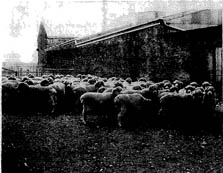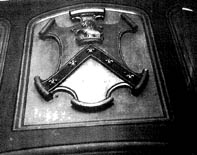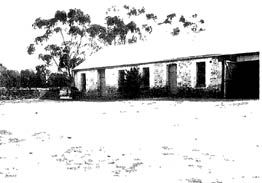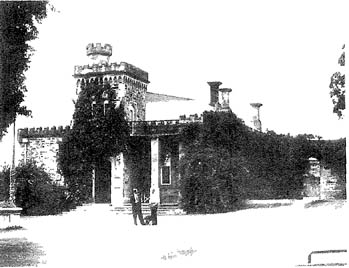History of Turretfield
History of Turretfield
"History of Turretfield" is chiefly the work of the late John R. Goode who died on July 24, 1965, in the prime of life when he was officer-in-charge of the Turretfield Research Centre.
John Goode graduated in agricultural science and joined the staff of the Waite Agricultural Research Institute. He served with the A.I.F. and on return was appointed to the B.H.P. at Whyalla as agricultural officer and Manager of the widely known dairy farm. He went to South America in 1953 with FAO on beef advisory work.
At one period he managed a South-East property. He joined the Department of Agriculture in 1959 and found much to interest him in pastures, livestock and history at Kybybolite. He went to Turretfield in 1961.
His widow now lives at Belair. She had spent some time assisting her husband in detailed checking and searches for historical details. She and her young family of seven were enchanted with the old Holland House on Turretfield Estate.
John Goode was buried in the Church of England cemetery at Lyndoch, not far from the place which had aroused his inquiring mind.
The story of Turretfield, the Department of Agriculture's Research Centre about thirty five miles north-east of Adelaide, begins more than 130 years ago.
The earliest mention of settlement in the area was of the South Para River ford at Gawler, n ow known as Dead Man's Pass. Reference was made to this portion being grazed by sheep belonging to explorer John Ainsworth Horrocks in the period from 1836 to 1838.
This point has been denied by Elizabeth Mahoney (a daughter of pioneer John Reid) who wrote that Horrocks only passed through Gawler on his way with sheep to Penwortham in October, 1839.
More certain history is tied with the name of Murray,which still has meaning in Gawler and nearby districts.
Henry Dundas Murray, youngest son of Sir Patrick Murray, 42nd Highlanders, of Ochtertyre, Perthshire, ana nephew of Sir George Murray, master of Ordinance and one of Wellington's generals, came to S.A. in the barque "Orleana" (68 tons), departing Liverpool on October 5, 1838, and arriving on January 15, 1839. He immediately purchased (on January 28, 1839) 2,422 acres at £1 per acre of the 4,000-acre Gawler Special Survey No. 2, in a district of 15,000 acres, of which 1,578 acres (7 blocks of 134 acres, and eight blocks of 80 acres) had been purchased in England by John Reid, of Newry, Ireland, who came out on the "Orleana" with Murray.
The survey was split into seven selections, leaving 240 acres for the township of Gawler. John Heid (father of W.L. Reid of Tolarno Station on the River Darling) kept 600 acres for his Clonlea estate; Stephen King ("Orleana" passenger, and father of the explorer) bought 500 acres for Kingsford; Henry Murray acquired 516 acres (Section 23, Hd. Barossa) where Turretfield now is; three blocks were taken by Henry Johnstone, and later transferred to Moore, Wright and Jerningham's Para Para estate. The last selection of 500 acres was bought by Murray's shepherd, Alexander McCulloch, who came out with him in the "Orleana", and subdivided by his friends, Thomas Stubbs, James Fotheringham and John Lindsay Patterson. McCulloch later bought Yongala run; his substantial buildings are still standing on the station.
A.M. Murray, J. Reid, S. King, H. Johnstone, W.F. Porter, Patrick J. Todd, Robert Todd (of reservoir fame), J.L. Patterson, James Fotheringham, Thos. Stubbs, John Sutton and the Rev. C.B. Howard took up 11,000 acres of depasturing lease of the 15,000 acres of the Gawler Special Survey.
By 1840 Stephen King had 3,250 sheep and a few cattle on Kingsford; but he was forced out by the 1860s drought.
Henry Murray was not related to the Merino stud breeders at Mt. Crawford - John and A.B. Murray, the latter being one of the original settlers of the Barossa Special Survey in 1841, starting the Mt. Crawford Station in 1843, and then taking up Wirrabara in 1866. John Murray started Sandy Creek Station in 1843.
Peter Lawes, who came out in 1838, took up land at Tiltshead, Sandy Creek (now belonging to Mrs. Hoe); and his brother James started Woodlands in 1842 (now owned by grandson Gordon). At the same time two other brothers took up land in the same district Thomas at Wontadilla (now owned by J.T. AlIen, Sandy Creek), and the other at Nettlebeck's old vineyard. The Nettelbeck property was originally taken up by Matthew McCallum in 1842, the family now being at Morchard. He married James Lawes' daughter and the property was called The Glen; it was sold to Mr. Schrapel; and then in 1921 to the Nettelbecks. Riverside was founded by Joseph Barritt in the late 1840s - purchased from
the Crown - and the house completed in 1858.
Mr. and Mrs. George Causby reached S.A. in July, 1847 in the same ship as Henry Dundas Murray, who was returning to settle after seven years away visiting N.S.W., Tasmania and Scotland. They came to Gawler on the recommendation of Mr. Murray, as he was anxious that they should settle on his land at Turretfield. Mr. Murray on his previous visit had camped on the Gawler parklands, and he pointed out to Mrs. Causby the spot where he had slung his hammock. His journey to Gawler in 1839 was graphically described by John Reid' s daughter in "Reminiscences of Mrs. Elizabeth Mahoney". Most of his sheep and cattle at Turretfield had been brought overland from N.S.W.
At that time there was no profitable sale for stock, and it was thought that converting their carcasses to tallow would pay. So the Gawler Boiling Down Establishment, down river from Clonlea, belonging to Reid and Devlin, where 106 sheep per day were rendered down, yielding about 24 lb. tallow per sheep, was acquired by Murray and Turner.
In 1849, this establishment was transferred to Turretfield, where great stock yards were erected, houses for vats built, and a substantial brick and stone building and dwelling house put up for a woolwashing and boiling down works on the land said to be bought from Mr. Murray, but purchased by Hermann Kook from the Crown in 1849. The house was later occupied by Johannes Zerk; and is now known as Eime's ruin.
There were no white people between Gawler and Turretfield along the left bank of the river then, but plenty of aborigines, who gave no trouble as they were well treated. This land had only scrub on it, except for the heavy red gums towards the river; and would have been much as Heinjus Hill is now.
Both the North and South Para Rivers were much more frequently in flood in those days, causing great inconvenience to the Causbys, who soon left Turretfield to keep the Old Bushman Inn - a pine hut in Cowan Street, Gawler, built by Hobert Hobertson (sea captain) in about 1844.
The inn was the second to be built in Gawler and was in time to meet the copper mining trade from the Kapunda mine opened in 1842. Capt. C.H. Bagot's use of a limb from a tree to mark a track gave rise to the town Sheaoak Log which is not far from Rosedale.
The Causby's later ran the Globe Hotel in Gawler. They had migrated in the "Belle Alliance" which left Plymouth on April 4, 1847 with 294 emigrants and arrived in the S.A. Colony on July 7. Cabin passengers were H.D. Murray, J.B. and W.D. Were and G.H. Fox.
Henry Murray was appointed Special Magistrate in 1851 while living at Turretfield. He went to live in Gawler in 1853, marrying Miss June Lewis of Smithfield, and then to farm in N.Z. in 1860, where he died in 1882.
The village of Rosenthal (now Rosedale) and St. Martin's Lutheran Church were founded in 1849 by about fifty German settlers who came to live near Sandy Creek and along the North Para River. By 1855 the congregation of St. Martin's numbered up to 450; their original church and meeting place being about half a mile south-east of Causby's works.
The Turretfield estate, being Section 23, Hd. Barossa, is said to have been sold by Henry Murray to Richard Holland; but the transfer was registered on May 13, 1853 of thirty five acres known as Turretfield on the North Para River to Richard Holland, gentleman of Holland House, Rosenthal, from Johann Andreas Kablitz, who lived on the south corner of the junction of the Rosedale road and the private lane leading to Elix and Harrison's watermill on Section 675 of the present Turretfield property.
On February 18, 1853 the grant from the Crown was registered by Richard Holland of Sections 838 and 839 (both now Section 674) Hd. Nuriootpa, comprising 936 acres, for 2 guineas an acre. The land was ring fenced in 1853 with a substantial wire fence - one of the Colony's first.
Holland House, of 12 rooms, twin turrets and castellated walls, was built in the Gothic style by James MacGeorge, architect and surveyor, about 1854, at the same time as the watermill, on a commanding site overlooking the confluence of the North Para River and Walker (now Salt) Creek. Henry Murray's old home, where the Causby's probably first lived, stood close to its entrance gates, just south of an old fig tree which is still
standing.
The main street of Gawler is named after Murray; and a creek entering the North Para River between the Rosedale school and Turretfield is known as Holland Creek. The English freestone of the turrets and south hall of Holland House was probably imported as ship's ballast; as was the stone used for Kingsford, Stephen King's neighbouring homestead, built in 1856.
Two bridges were built across the North Para River by The Barossa District Council, one at Rosedale and the other in front of the Turretfield homestead; both were there in 1862, but the first was destroyed by the 1863 floods, and the Turretfield bridge went in 1864. These same floods broke the dam of Harrison's watermill, which was then operated by steam. The chimney still stands, as well as part of the dam wall and water duct.
Holland House was supposedly modelled on Holland House, Kensington, London, which dated from 1607 and was originally designed for a bride who died.
Richard Holland was born in N.S.W. in 1815, but the connection between the English and Australian families is not known. Details of Holland House in London appear in "The Holland House Circle", by L.C. Sanders, published in 1908.
Richard Holland was born on August 11, 1815 near Windsor, N.S.W. His father, also Richard Holland, had come to Australia in 1806, and married Mary Roberts in 1813.
Richard Holland moved to S.A. and did well with land and stock. In about 1849 he married the widow of Captain Robert Robertson (nee Margaret Harper) and took under his wing her three sons John (born January 15, 1842), William (born December 5, 1844) and Robbie (born November 5, 1846). Holland was appointed a Justice of the Peace on December 2, 1863. He was a big powerful John Bull - type of man with keen interests in horse racing and in the Gawler Committee. Some of his blood stock won races in neighbouring colonies.
In 1862, Turretfield consisted of 1,800 acres with 5,000 sheep running on it, and 7,000 acres of land at Port Gawler. The first crop of wheat in that year was sown to the Goldsmith variety, with 70 acres of potato oats, yielding 40 bushels an acre, and 70 acres of cereal hay. The crops were mown by scythe, the swathe thrown against the standing crop, bound into sheaves at once, and later thrashed by machine. The straw stacks were chaffed and steamed for cattle and sheep feeding. The same price of 15/- per acre was paid for both mowing and reaping with sickle.
A 4-year rotation operated, the stubble being self-grown after feeding off with sheep. The green wheat crop was grazed until September when the weaners of the May lamb drop were sold as fats. The pastures were then broken up for summer fallowing. The sheep were washed either in still pools or running water before shearing. Hurdles on wheels were used for holding the pure Merinos.
The property ran four brood mares brought from Sydney, an imported Shorthorn bull named "Fandango", Berkshire pigs and Creeping Malay fowls. One account of the Gawler Show in 1861 records Richard Holland scoring with colonial bred cattle, as well as pigs and horses.
He used an underground tank, then unique in the Colony, for conserving water from the main house and adjoining offices. The stable had a granary loft; and there was a large garden with all kinds of fruit on the river flat, where maize, sorghum, sugar cane and oats were also cultivated.
Later, two Melloor strippers were used to harvest the wheat grown on the southern end of the big block, worked by the young Robertsons. The strippers had 3 ft. combs without a front wheel, the shaft horse carrying the weight of the machine and doing the steering, with a leading horse in tandem.
Richard Holland and his three stepsons were interested in pastoral enterprises; and the stations Bookmark, Chuwilla and Calperum were acquired at this time. Holland died on November 25, 1881, aged 66 - his last request was that he should be buried by a Church of England clergyman under the tower stairs where he had built a mausoleum. A difficulty arose through the burial ground not being consecrated; but the service was conducted on November 28 by the Rev. Sells of Lyndoch in the main hall of Holland House, and the body laid in the vault. The two coffins of cedar and one of lead not being airtight, he was later reburied at Gawler. His executors were George Warren, Edward Meade Bagot
(of Ned's Corner fame and son of Capt. C.H. Bagot) and Samuel Tomkinson.
Robbie Robertson bought Turretfield at a high price in order that his mother might end her days there. On the death of Margaret Holland on December 21, 1898, aged 82, the household furniture was sold by auction, the whole sale taking two days.
George Harper, Mrs. Holland's brother, lived at Turretfield, then farmed near Smithfield, but lived at Goodwood Park. He died aged 87 on February 9, 1901. His funeral at West Terrace was attended by only his nephew Willie Robertson and David Fotheringham.
In 1887, Turretfield, Bookmark and Bookpurnong were transferred to Willie by John Holland Robertson (then at Calperum Station) and Robert Robertson (Chowilla Station), but were mortgaged two years later to Samuel Davenport, John Roward Angas of Collingrove, and John Hall Angas, a minister in Victoria.
Willie Robertson actually took over Turretfield in 1876 when he was 31, to breed racehorses; and photographs of it as it was then are in the Gawler and Adelaide Archives. Willie Robertson married Miss Blanche Scott of Wentworth, and with bad times at Nickavilla, Queensland, acquired Gunyah near Wilmington, where his son Scott then settled.
Later, Turretfield passed into the hands of Henry Angas Evans of Ivanhoe, Keyneton in 1889; and when he died, to his widow, Mary Anne Evans, and Fred Lavington Evans in 1901.
In 1900 George Lillecrapp came to Turretfield from Kapunda, having married Miss Ada Evans, and he continued the established practice of wheat and sheep farming, his daughter, Mrs. Neville Keynes of Keyneton, remembering his pressing wool in the shearing shed at night while dictating business letters to her mother.
On November 14, 1900 the property of 1,604 acres was bought by the SA Government for 10 guineas an acre, being Sections 571, 674, 675 and 676, H.d Nurioopta, and Sections 1709 and 1712, Hd. Barossa.
More than a century ago, soils of the area had been very fertile. But by 1900, layers of soil had disappeared and in places only bare clay patches were left. The first wheat crops were grown without fertilizers and yielded 40 bushels an acre, but since then, and in the period of Government ownership, it has required skills to bring production up to a good level.
In 1908 the Department of Agriculture established it as a dairy and stud farm under the charge of P.H. Suter who reported, "It is only a matter of a short time when many young bulls from deep-milking ancestors will be available".
The farm bought Victorian Milking Shorthorns and some famous South Coast Shorthorns from N.S.W. A Jersey sire, "Antimony", was given by Alick Murray. A line of Ayrshires was added and a gift of Red Danish stock was received from Canowie Pastoral Company. Bulls were to be bred for cereal farms.
Following Suter, the farm was run by, in turn, Messrs. Apps, Wilson and J. Brown, until G.H. Stevens became Officer-in-charge of the property, which was named the Turretfield Experimental Farm.
In 1918, F.E. Waddy took over and remained for 20 years. From 1921 to 1932, he managed a program aimed at costing wheat production and under a plan to have a "demonstration" farm running on business lines.
In charge of the research was Professor A.J. Perkins, well known as principal of Roseworthy Agricultural College and later as the Director of Agriculture. He had to report eventually that the results on the work at Turretfield in the difficult years had been disappointing - later the value of his work was appreciated.
In 1933, Turretfield was run as a stud wheat farm after it had survived a closure threat as a result of the National Economic Depression which had caused the sale or closing down of other State farms.
The present Central Districts Agricultural Adviser, F.C. Gross, took charge on the retirement of F.E. Waddy, on April 13, 1938. Under the late Mr. Waddy, seed wheat was produced and sold to leading farmers who made good use of it. Experimentalist L.J. Cook wrote in 1937 of the good seed wheat demand and of a plan to run Corriedales.
Mr. Gross recently spoke of the farm and the original farm house which had been occupied by the overseer or foreman. The stone and mortar walls and shingle roof had needed repair so, during the war years, materials were removed to use in other buildings. It was possible that the walls were partly roofed and the structure used for a dairy but no trace was left today, he said.
In 1945, E.L. Orchard became the manager of Turretfield. He was a Roseworthy College graduate of 1909, and became the
College's farm manager. Later in 1927, he was appointed to Jamestown as one of the Department's first district agricultural
advisers.
In June 1967, Mr. Orchard, now of Clare, recalled the hard times of his eight-year term at Turretfield where his wife had died in the turreted house.
In 1953, J.B. Doolette was assisted by H.C. Nourse in applying a new pattern to the running of the farm. They proceeded further with contour banking, had paddocks re-designed and introduced subterranean clovers.
Different rotations lifted soil fertility and gradually the farm was rehabilitated through pasture phase-farming, the use of insecticides and short cropping periods. The activities of the farm changed from seed wheat growing to research. In 1955 the Director of Agriculture Dr. A.R. Callaghan, reported, "Turretfield farm is being re-organized. It was formerly a pure seed wheat farm, but will now become an important centre for applied research in agronomy, animal husbandry and soil conservation.Multiplication and distribution of pure seed will continue".
In January, 1961, Mr. Doolette, now Principal Research Officer in agronomy at the Northfield Laboratories, was posted to Adelaide and Mr. Nourse acted as manager.
On July 14, 1961, John Reginald Goode moved into Turretfield to live in Holland House. His previous post was at the Kybybolite Research Centre.
Mr. Goode noted that wheat yields had been doubled and wool cuts trebled over the comparatively few years previous to the 1960s. He wrote in the original of his notes, "The farm foreman W.S. Cooper, who joined the staff on May 3, 1924, under F.E. Waddy, has stayed with it through all these changing fortunes; and today, has the pleasure of seeing it at its highest peak of production".
In May 1966, Henry Day moved into Holland House and became Officer-in-Charge. He had previously held a similar position at the Parndana Research Centre on Kangaroo Island.
The Turretfield Research Centre now has a well ordered farm carrying Koonoona strain Merinos, commercial beef cattle, crops of Noyep and Prior seed barley, various wheat varieties for testing, new and old pea types and facilities for research work on lambing, nutrition, weaning and other sheep trials.
|
Mr. Bill Cooper, farm foreman, by the fig tree near the site of the original house at Turretfield. |
Part of the ewe flock at Turretfield Research Centre, April 1967. |
|
The Holland family crest, which still survives in the house at Turretfield today. |
Old farm building at Turretfield. |
|
Turretfield, about 1880 |
Turretfield about 1967 |
|
The grave of Richard Holland and his wife, Margaret |
The headstone of the grave of Richard and Margaret Holland |








